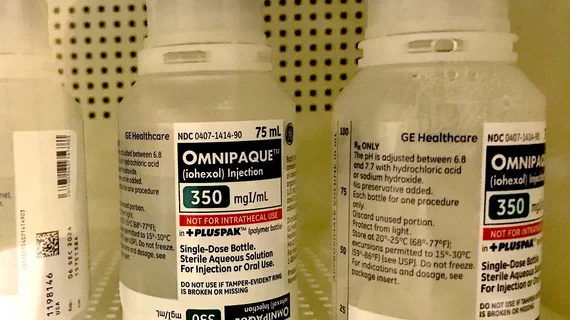Supply crunch forces ED to develop contrast use mitigation protocol for PE
A study found that implementing a contrast use mitigation protocol in the emergency department (ED) reduced CT pulmonary angiography (CTPA) utilization for suspected pulmonary embolism (PE), all without sacrificing diagnostic accuracy.
Researchers at Emory University School of Medicine in Atlanta developed the protocol for PE during a global iodinated contrast shortage. The lack of reduction in diagnostic accuracy suggests a potential for optimizing imaging strategies in EDs, especially in a time where supply constraints could be leaving hospitals and health systems with less contrast than they need. The results are published in Clinical Imaging. [1]
“The purpose of this study was to assess how a contrast mitigation strategy impacted CTPA and ventilation-perfusion (VQ) scan use and positivity rates in ED patients with suspected PE and if the new strategy has caused any delays in the imaging process or ED length of stay for the patients.” the authors led by Francisco Delgado wrote. “We hypothesized that our institution's contrast mitigation strategy would reduce imaging without compromising PE detection rates or wait times at our institution.”
Delgado and the other researchers looked at 610 scans performed in the ED, of which 28 were excluded because they were not consistent with PE. The images were all taken from March 15, 2022, to June 15, 2022, with a split for control occurring when contrast mitigation protocols for PE were implemented on May 15. Time metrics, including image processing and patient length of stay, were recorded for comparison.
During the test period, the ED saw a significantly lower overall imaging rate (4.16%) compared to the control (6.54%), with a notable decrease in CTPA usage by 47.73%. However, VQ scan usage increased substantially by 775% during the test period, though there were no apparent changes in patients’ average length of stay in the ED or image acquisition times. Positivity rates of PE between the test and control periods were also comparable.
Despite a reduction in CTPA scans and contrast use, the authors said the mitigation protocol may only work during a supply crunch, and the results could be limited to PE. Concerns “persist about unnecessary imaging and low positivity rates, necessitating further research to optimize PE diagnostic algorithms,” they concluded.
Read the full study at the link below.

